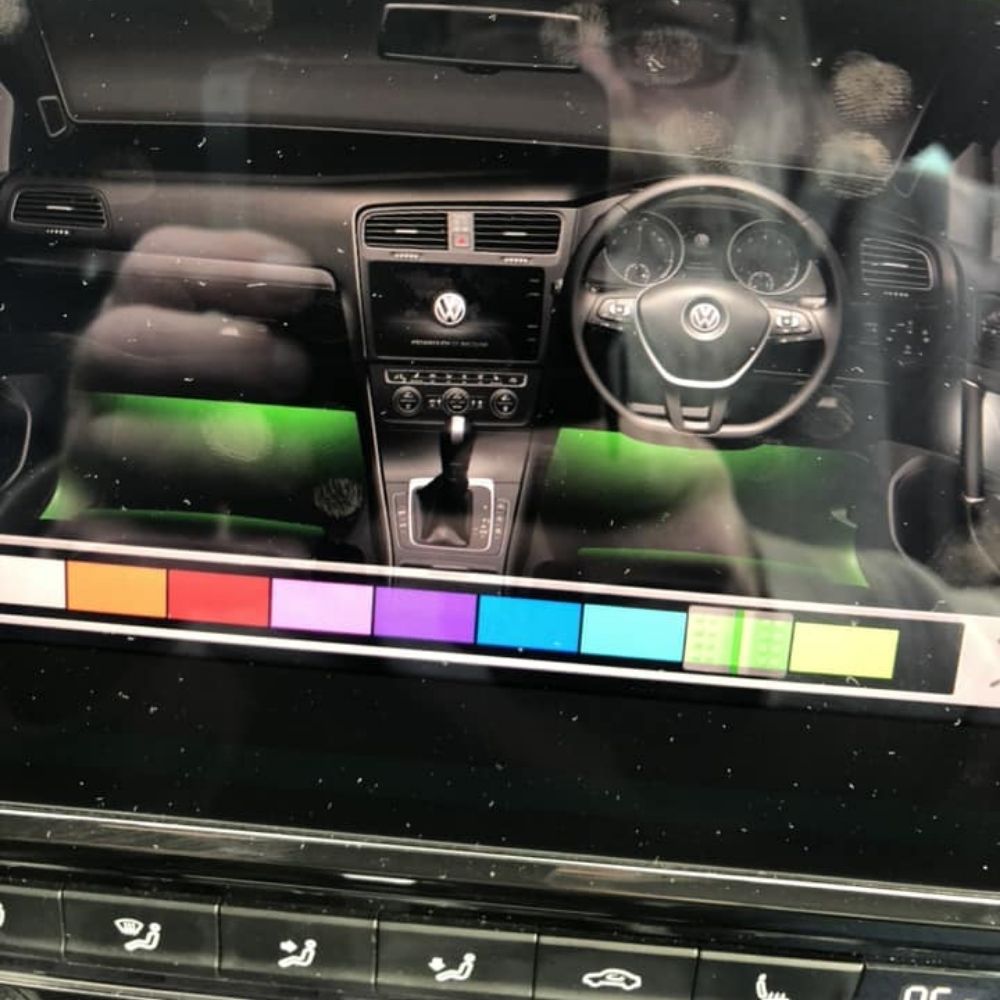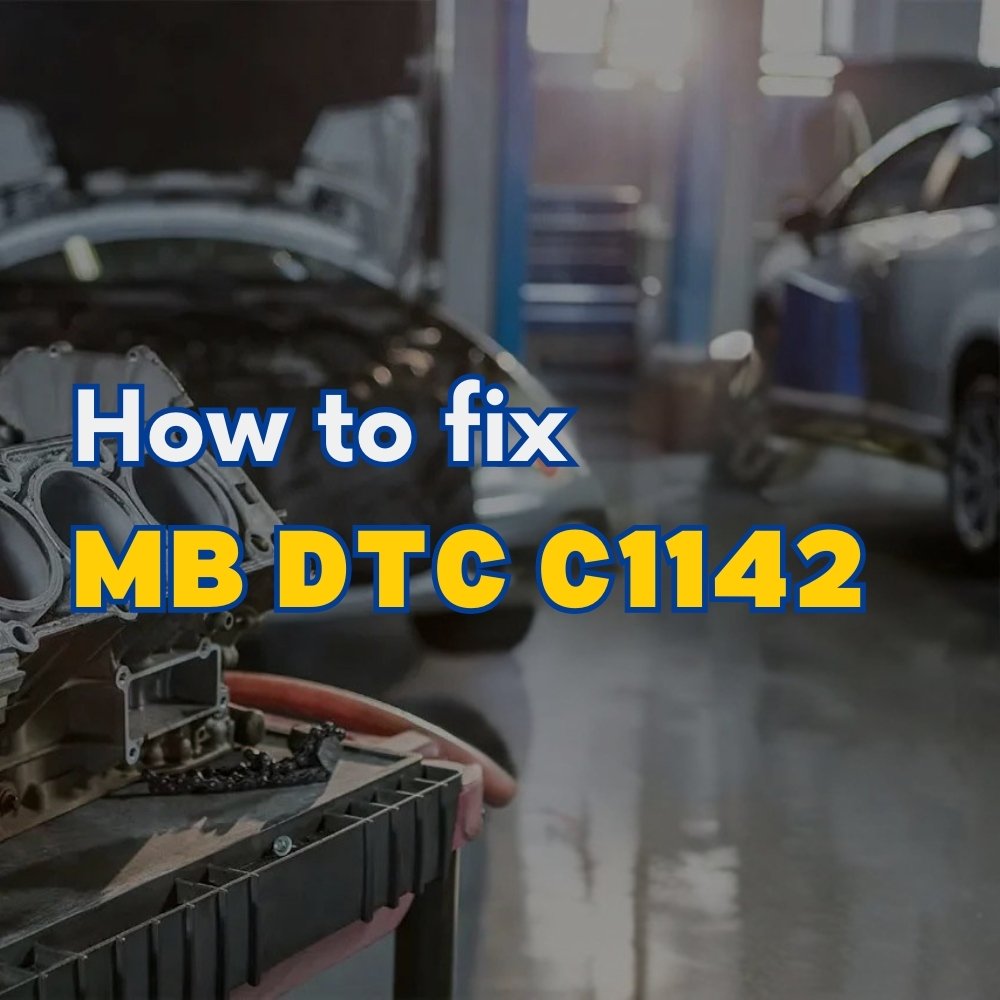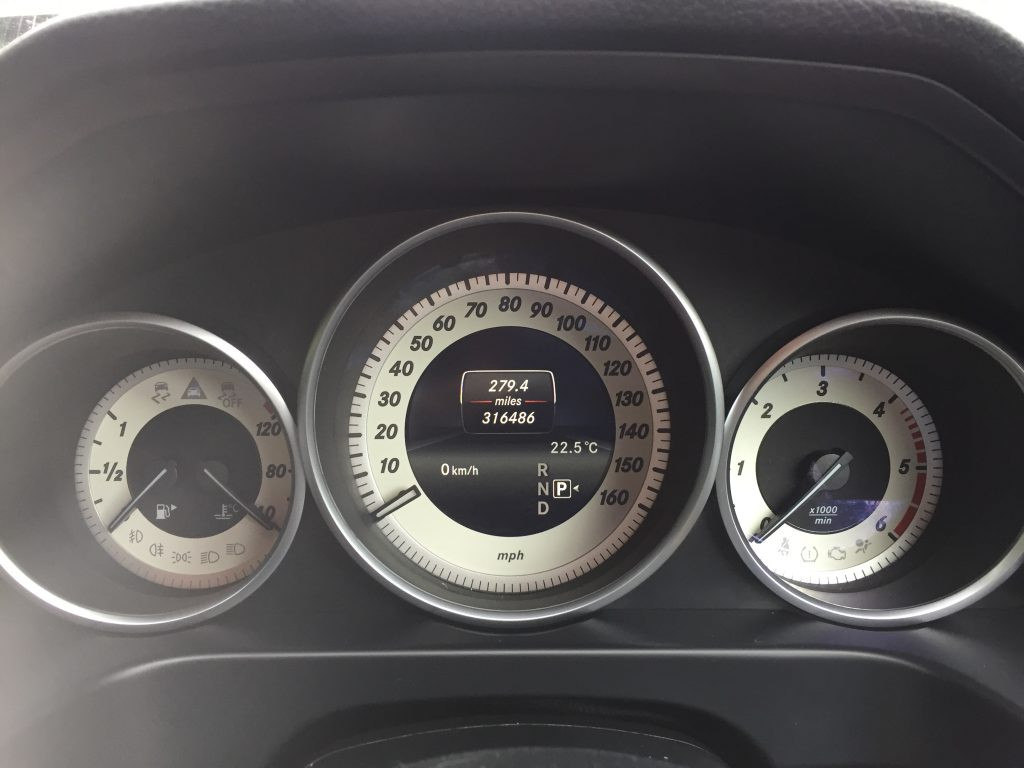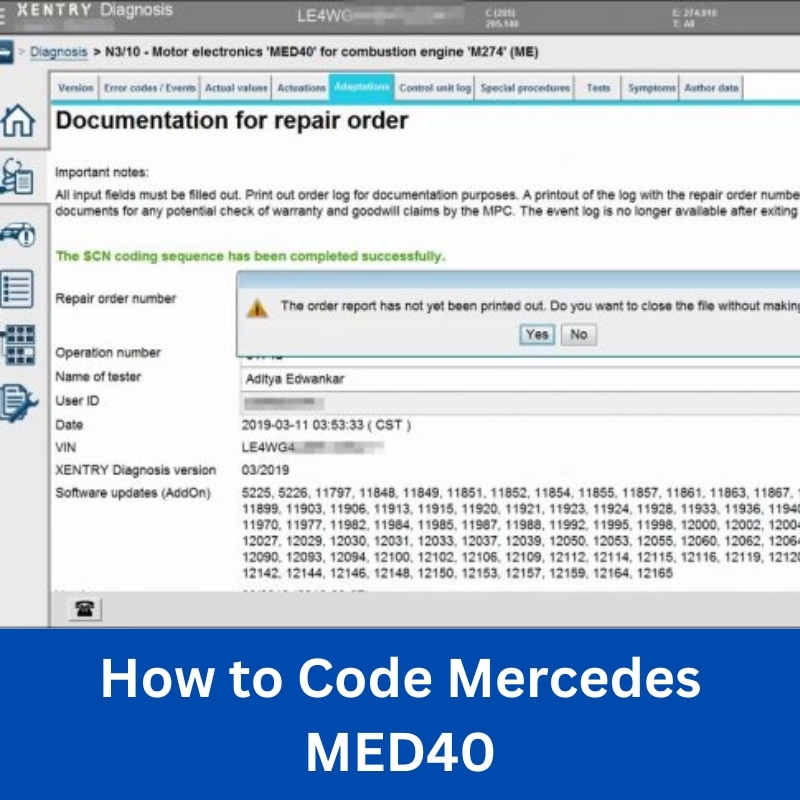
Mercedes Fault Code P0715: Expert Diagnosis And Solutions
Contents
- 1. Understanding Mercedes Fault Code P0715
- 1.1. What Does Code P0715 Mean?
- 1.2. Symptoms Associated with P0715
- 1.3. Common Causes of P0715
- 2. Detailed Diagnostic Steps for Mercedes Fault Code P0715
- 2.1. Preliminary Checks
- 2.2. Retrieving and Clearing Codes
- 2.3. Testing the Input/Turbine Speed Sensor
- 2.4. Checking the Wiring and Connectors
- 2.5. Using a Scan Tool for Live Data
- 2.6. Advanced Diagnostic Procedures
- 3. Step-by-Step Repair Guide for Mercedes Fault Code P0715
- 3.1. Replacing the Input/Turbine Speed Sensor
- 3.2. Repairing Wiring and Connectors
- 3.3. Addressing Transmission Fluid Issues
- 3.4. TCM Reprogramming or Replacement
- 4. Advanced Tips and Tricks for Troubleshooting P0715
- 4.1. Understanding Sensor Types and Operation
- 4.2. Using an Oscilloscope for Signal Analysis
- 4.3. Checking for Intermittent Faults
- 4.4. Verifying TCM Ground Connections
- 4.5. Diagnosing CAN Bus Issues
- 4.6. Common Mistakes to Avoid
- 5. Maintaining Transmission Health to Prevent P0715
- 5.1. Regular Transmission Fluid Changes
- 5.2. Inspecting and Maintaining Sensors
- 5.3. Monitoring Transmission Performance
- 5.4. Avoiding Harsh Driving Habits
- 5.5. Keeping the Vehicle Properly Serviced
- 6. How AutoExplain.com Can Help with Your Mercedes P0715 Fault Code
- 6.1. Remote Diagnostic Assistance
- 6.2. Wiring Diagrams and Technical Resources
- 6.3. Programming and Software Support
- 6.4. Component Testing and Validation
- 6.5. On-Demand Support via WhatsApp and Email
- 6.6. Benefits of Choosing AutoExplain.com
- 7. Real-World Case Studies: Resolving P0715 with AutoExplain
- 7.1. Case Study 1: Faulty Input Speed Sensor
- 7.2. Case Study 2: Wiring Harness Damage
- 7.3. Case Study 3: Transmission Fluid Contamination
- 7.4. Case Study 4: TCM Reprogramming
- 8. FAQs: Mercedes Fault Code P0715
- 8.1. What Does Mercedes Fault Code P0715 Indicate?
- 8.2. Can I Drive My Car with Code P0715?
- 8.3. What Are the Common Symptoms of Code P0715?
- 8.4. What Are the Possible Causes of Code P0715?
- 8.5. How Do I Diagnose Code P0715?
- 8.6. Can I Fix Code P0715 Myself?
- 8.7. How Much Does It Cost to Fix Code P0715?
- 8.8. How Can AutoExplain.com Help Me Fix Code P0715?
- 8.9. What Should I Do After Repairing Code P0715?
- 8.10. How Can I Prevent Code P0715 in the Future?
- 9. Contact AutoExplain.com for Expert Assistance
- 9.1. Get in Touch Today
- 9.2. How to Reach Us
- 9.3. Why Choose AutoExplain.com?
Mercedes Fault Code P0715 indicates a malfunction in the input/turbine speed sensor circuit, and AutoExplain.com offers the solutions you need. Let’s explore the causes, symptoms, and diagnostic procedures for this fault code, and how AutoExplain’s expertise can ensure efficient and accurate repairs, and our remote support ensures expert assistance is always within reach. Understand sensor failures, circuit issues, and TCM problems.
1. Understanding Mercedes Fault Code P0715
Mercedes Fault Code P0715 is registered when the Transmission Control Module (TCM) detects an issue with the input or turbine speed sensor circuit. This sensor is critical because it monitors the rotational speed of the transmission’s input shaft, providing essential data for gear shifting and overall transmission performance. When this sensor malfunctions, it can lead to a range of problems, affecting driveability and potentially causing damage to the transmission.
1.1. What Does Code P0715 Mean?
The code signifies that the signal from the input/turbine speed sensor is either absent, erratic, or inconsistent with other sensor readings. The input speed sensor measures the revolutions per minute (RPM) of the transmission’s input shaft, which is connected to the engine via the torque converter. The TCM uses this data to determine the appropriate gear and to control the transmission’s shift points.
1.2. Symptoms Associated with P0715
Several symptoms can indicate the presence of Mercedes Fault Code P0715. Recognizing these signs early can help prevent further damage and ensure timely repairs. The symptoms include:
- Check Engine Light: The most immediate sign is the illumination of the Check Engine Light on the dashboard.
- Erratic Shifting: The transmission may shift erratically, with abrupt or delayed gear changes.
- Harsh Shifting: Shifts may feel rough or harsh, especially during acceleration or deceleration.
- Transmission Slipping: The transmission might slip, causing a delay in acceleration or a loss of power.
- Stalling: In some cases, the vehicle may stall, particularly when slowing down or coming to a stop.
- Limp Mode: The transmission may enter limp mode, restricting the vehicle to a single gear to prevent further damage.
- Reduced Fuel Economy: Inefficient transmission operation can lead to decreased fuel efficiency.
1.3. Common Causes of P0715
Several factors can trigger Mercedes Fault Code P0715. Identifying the root cause is essential for an effective and lasting repair. Common causes include:
- Faulty Input/Turbine Speed Sensor: The sensor itself may be defective, providing inaccurate or no signal.
- Wiring Issues: Damaged, corroded, or loose wiring connecting the sensor to the TCM can disrupt the signal.
- Connector Problems: Corroded or loose connectors can impede the electrical connection between the sensor and the TCM.
- Contaminated Transmission Fluid: Dirty or degraded transmission fluid can affect the sensor’s performance.
- TCM Malfunction: In rare cases, the TCM itself may be faulty, leading to incorrect interpretation of the sensor signal.
- Mechanical Issues: Damage to the transmission’s internal components, such as the input shaft or turbine, can affect the sensor’s readings.
2. Detailed Diagnostic Steps for Mercedes Fault Code P0715
Diagnosing Mercedes Fault Code P0715 requires a systematic approach. The following steps provide a comprehensive guide for technicians to accurately identify the underlying issue.
2.1. Preliminary Checks
Before diving into advanced diagnostics, start with these preliminary checks:
- Visual Inspection: Inspect the input/turbine speed sensor, its wiring, and connectors for any visible damage or corrosion.
- Fluid Check: Check the transmission fluid level and condition. Ensure the fluid is clean and at the correct level.
- Battery Voltage: Verify that the battery voltage is within the specified range, as low voltage can cause erratic sensor readings.
2.2. Retrieving and Clearing Codes
- Connect Diagnostic Tool: Use an OBD-II scanner to retrieve all stored fault codes.
- Record Codes: Note all codes, including any related to the transmission or engine.
- Clear Codes: Clear the codes and perform a test drive to see if P0715 returns.
2.3. Testing the Input/Turbine Speed Sensor
- Resistance Test: Disconnect the sensor and use a multimeter to measure its resistance. Compare the reading to the manufacturer’s specifications. An open or shorted sensor indicates a fault.
- Voltage Test: With the ignition on, check for voltage at the sensor connector. There should be a reference voltage, typically 5V or 12V, depending on the vehicle.
- Signal Test: Use an oscilloscope to monitor the sensor’s signal while the engine is running. The signal should be a clean, consistent waveform. Erratic or absent signals indicate a problem.
2.4. Checking the Wiring and Connectors
- Continuity Test: Use a multimeter to check the continuity of the wiring between the sensor and the TCM. Open circuits indicate broken or damaged wires.
- Short Circuit Test: Test for short circuits by checking for continuity between the sensor wiring and ground. Any continuity indicates a short.
- Connector Inspection: Inspect the connectors for corrosion, damage, or loose pins. Clean or replace connectors as needed.
2.5. Using a Scan Tool for Live Data
- Monitor Sensor Data: Use a scan tool to monitor the input/turbine speed sensor’s data in real-time. Compare the sensor’s readings to the output speed sensor and other related parameters.
- Check for Consistency: Ensure that the input speed sensor’s readings are consistent with the engine speed and vehicle speed. Inconsistent readings suggest a sensor or wiring issue.
- Record Data: Record the live data during a test drive to capture any intermittent faults or discrepancies.
2.6. Advanced Diagnostic Procedures
- TCM Testing: If the sensor and wiring tests are inconclusive, the TCM may be the issue. Consult a specialist for TCM diagnostics and potential reprogramming.
- Transmission Inspection: In cases where internal transmission damage is suspected, a thorough inspection by a transmission specialist may be necessary.
3. Step-by-Step Repair Guide for Mercedes Fault Code P0715
Once the diagnostic steps have pinpointed the problem, the following repair guide provides a detailed approach to resolving Mercedes Fault Code P0715.
3.1. Replacing the Input/Turbine Speed Sensor
- Locate the Sensor: Identify the location of the input/turbine speed sensor on the transmission. It is typically mounted on the transmission case.
- Disconnect Electrical Connector: Disconnect the electrical connector from the sensor.
- Remove the Sensor: Remove the sensor from the transmission case. This may involve unscrewing a bolt or clip.
- Install New Sensor: Install the new sensor, ensuring it is properly seated and secured.
- Reconnect Electrical Connector: Reconnect the electrical connector to the sensor.
- Test the System: Use a scan tool to clear the fault codes and monitor the sensor’s data to ensure it is functioning correctly.
3.2. Repairing Wiring and Connectors
- Identify Damaged Wires: Locate any damaged, corroded, or broken wires in the sensor circuit.
- Repair or Replace Wires: Repair damaged wires by splicing in new sections of wire and using heat-shrink tubing to protect the connections. Replace severely damaged wires entirely.
- Clean Connectors: Clean corroded connectors with a wire brush or electrical contact cleaner.
- Replace Connectors: Replace damaged or corroded connectors with new ones.
- Test the Circuit: Use a multimeter to test the repaired circuit for continuity and shorts.
3.3. Addressing Transmission Fluid Issues
- Drain the Old Fluid: Drain the old transmission fluid from the transmission pan.
- Inspect the Pan: Inspect the transmission pan for debris or metal shavings, which can indicate internal transmission damage.
- Replace the Filter: Replace the transmission filter to ensure clean fluid flow.
- Reinstall the Pan: Reinstall the transmission pan with a new gasket.
- Fill with New Fluid: Fill the transmission with the recommended type and amount of new transmission fluid.
- Check Fluid Level: Check the fluid level and adjust as necessary.
3.4. TCM Reprogramming or Replacement
- Consult a Specialist: TCM reprogramming or replacement should be performed by a qualified technician with the appropriate diagnostic equipment and software.
- Reprogram the TCM: Reprogram the TCM with the latest software updates from the manufacturer.
- Replace the TCM: If the TCM is faulty, replace it with a new or refurbished unit.
- Verify Operation: After reprogramming or replacement, verify the TCM’s operation by performing a test drive and monitoring the sensor data.
4. Advanced Tips and Tricks for Troubleshooting P0715
Effective troubleshooting requires a blend of technical knowledge and practical experience. Here are some advanced tips and tricks to help diagnose and resolve Mercedes Fault Code P0715 more efficiently.
4.1. Understanding Sensor Types and Operation
- Hall Effect Sensors: Many input/turbine speed sensors are Hall effect sensors, which use a magnetic field to generate a signal. Understanding how these sensors work can aid in accurate diagnosis.
- Variable Reluctance Sensors: Some vehicles use variable reluctance sensors, which generate an AC voltage signal. Knowing the type of sensor can help in testing and troubleshooting.
4.2. Using an Oscilloscope for Signal Analysis
- Waveform Analysis: Use an oscilloscope to analyze the sensor’s waveform. A healthy signal should have a consistent amplitude and frequency.
- Identifying Signal Issues: Look for signal dropouts, noise, or distortion, which can indicate wiring problems or a faulty sensor.
4.3. Checking for Intermittent Faults
- Data Logging: Use a scan tool to log sensor data during a test drive. This can help capture intermittent faults that may not be present during static testing.
- Stress Testing: Perform stress tests, such as wiggling wiring harnesses or applying heat to the sensor, to try to induce the fault.
4.4. Verifying TCM Ground Connections
- Ground Integrity: Ensure that the TCM has a good ground connection. Poor ground connections can cause erratic sensor readings and other electrical issues.
- Testing Ground Resistance: Use a multimeter to measure the resistance between the TCM ground terminal and the vehicle chassis. The resistance should be close to zero ohms.
4.5. Diagnosing CAN Bus Issues
- CAN Bus Communication: The TCM communicates with other modules via the Controller Area Network (CAN) bus. Issues with the CAN bus can affect sensor data and trigger fault codes.
- Checking CAN Bus Signals: Use an oscilloscope to check the CAN bus signals for proper communication. Look for signal integrity issues, such as voltage drops or signal interference.
4.6. Common Mistakes to Avoid
- Overlooking Wiring Issues: Many technicians focus on the sensor itself and overlook wiring problems. Always thoroughly inspect the wiring and connectors.
- Failing to Check Fluid Condition: Dirty or degraded transmission fluid can cause a variety of issues. Always check the fluid level and condition as part of the diagnostic process.
- Not Verifying Repairs: After performing repairs, always verify that the fault code has been resolved and that the system is functioning correctly.
5. Maintaining Transmission Health to Prevent P0715
Preventing Mercedes Fault Code P0715 involves regular maintenance and proactive care. Here are some best practices to keep your transmission in optimal condition.
5.1. Regular Transmission Fluid Changes
- Scheduled Maintenance: Follow the manufacturer’s recommended maintenance schedule for transmission fluid changes.
- Fluid Type: Use the correct type of transmission fluid specified for your vehicle.
- Benefits of Fresh Fluid: Fresh transmission fluid helps to keep the transmission clean, lubricated, and functioning properly.
5.2. Inspecting and Maintaining Sensors
- Regular Inspections: Periodically inspect the input/turbine speed sensor and other transmission sensors for damage or corrosion.
- Cleaning Sensors: Clean sensors as needed to ensure accurate readings.
- Replacing Worn Sensors: Replace sensors that show signs of wear or degradation.
5.3. Monitoring Transmission Performance
- Pay Attention to Symptoms: Be aware of any symptoms of transmission problems, such as erratic shifting or slipping.
- Early Detection: Address any issues promptly to prevent further damage.
5.4. Avoiding Harsh Driving Habits
- Smooth Acceleration: Avoid harsh acceleration and deceleration, which can put excessive strain on the transmission.
- Proper Gear Selection: Use the correct gear for the driving conditions.
5.5. Keeping the Vehicle Properly Serviced
- Regular Maintenance: Follow the manufacturer’s recommended maintenance schedule for all vehicle systems.
- Professional Inspections: Have the vehicle inspected by a qualified technician regularly.
6. How AutoExplain.com Can Help with Your Mercedes P0715 Fault Code
At AutoExplain.com, we understand the complexities of diagnosing and repairing modern vehicles. Our expert team is dedicated to providing comprehensive support and solutions for Mercedes Fault Code P0715, ensuring your vehicle runs smoothly and efficiently.
6.1. Remote Diagnostic Assistance
- Expert Technicians: Our team of experienced technicians is available to provide remote diagnostic assistance, helping you pinpoint the root cause of the P0715 fault code.
- Step-by-Step Guidance: We offer step-by-step guidance through the diagnostic process, ensuring accurate and efficient troubleshooting.
6.2. Wiring Diagrams and Technical Resources
- Comprehensive Resources: Access our extensive library of wiring diagrams and technical resources, providing detailed information on the input/turbine speed sensor circuit and related components.
- Accurate Information: Our resources are regularly updated to ensure accuracy and relevance.
6.3. Programming and Software Support
- TCM Programming: We offer TCM programming and software support, ensuring that your transmission control module is functioning correctly.
- Software Updates: Our team can assist with software updates and reprogramming to address any issues related to the P0715 fault code.
6.4. Component Testing and Validation
- Sensor Testing: We provide guidance on testing the input/turbine speed sensor and other related components to ensure they are functioning within specifications.
- Validation Procedures: Our team can help you validate the operation of the sensor and circuit after repairs have been made.
6.5. On-Demand Support via WhatsApp and Email
- Instant Assistance: Get immediate support from our expert technicians via WhatsApp for quick and efficient troubleshooting. Contact us at +1(936)2896695.
- Detailed Support: For more detailed inquiries, reach out to us via email at [email protected].
6.6. Benefits of Choosing AutoExplain.com
- Expertise: Our team of experienced technicians has the knowledge and skills to accurately diagnose and resolve Mercedes Fault Code P0715.
- Comprehensive Support: We offer a wide range of services, including remote diagnostic assistance, wiring diagrams, programming support, and component testing.
- Convenience: Our remote support services allow you to get the help you need from anywhere, saving you time and money.
- Reliability: We are committed to providing reliable and accurate information, ensuring that your vehicle is repaired correctly.
- Customer Satisfaction: Your satisfaction is our top priority. We strive to provide the best possible service and support.
By choosing AutoExplain.com, you can be confident that you are getting the expert assistance you need to resolve Mercedes Fault Code P0715 quickly and effectively. Contact us today to experience the difference our expertise can make.
7. Real-World Case Studies: Resolving P0715 with AutoExplain
To illustrate the effectiveness of AutoExplain.com’s services, here are a few real-world case studies where our expertise helped resolve Mercedes Fault Code P0715.
7.1. Case Study 1: Faulty Input Speed Sensor
- Vehicle: 2015 Mercedes-Benz C300
- Problem: The customer reported erratic shifting and a Check Engine Light. The OBD-II scanner revealed code P0715.
- Diagnosis: Using AutoExplain.com’s remote diagnostic assistance, the technician performed a series of tests on the input speed sensor and its wiring. The sensor’s resistance was out of specification, indicating a faulty sensor.
- Solution: The technician replaced the input speed sensor and cleared the fault codes. The vehicle’s shifting returned to normal, and the Check Engine Light was extinguished.
- Outcome: The customer was satisfied with the quick and accurate diagnosis, which saved them time and money.
7.2. Case Study 2: Wiring Harness Damage
- Vehicle: 2012 Mercedes-Benz E350
- Problem: The customer experienced harsh shifting and intermittent stalling. Code P0715 was present.
- Diagnosis: With guidance from AutoExplain.com, the technician inspected the wiring harness connecting the input speed sensor to the TCM. They found several damaged wires due to corrosion.
- Solution: The technician repaired the damaged wires and secured the wiring harness to prevent future issues. The fault codes were cleared, and the vehicle’s performance improved significantly.
- Outcome: The customer was impressed with the thorough diagnostic approach and the effective repair, which resolved the vehicle’s shifting and stalling problems.
7.3. Case Study 3: Transmission Fluid Contamination
- Vehicle: 2017 Mercedes-Benz GLC300
- Problem: The customer noticed slipping during acceleration and a decrease in fuel economy. Code P0715 was stored in the TCM.
- Diagnosis: AutoExplain.com’s technician advised checking the transmission fluid. The fluid was found to be dark and contaminated.
- Solution: The technician performed a transmission fluid flush, replaced the transmission filter, and refilled the transmission with new fluid. The fault codes were cleared, and the vehicle’s performance returned to normal.
- Outcome: The customer was pleased with the simple yet effective solution, which addressed the root cause of the problem and restored the vehicle’s performance.
7.4. Case Study 4: TCM Reprogramming
- Vehicle: 2014 Mercedes-Benz CLA250
- Problem: The customer reported delayed shifting and a Check Engine Light. Code P0715 was present, and sensor testing yielded normal results.
- Diagnosis: AutoExplain.com’s team suggested that the TCM might require reprogramming.
- Solution: The technician reprogrammed the TCM with the latest software updates. The fault codes were cleared, and the transmission began to function correctly.
- Outcome: The customer was grateful for the advanced diagnostic support, which identified the need for TCM reprogramming and resolved the vehicle’s shifting issues.
These case studies highlight the value of AutoExplain.com’s expertise in diagnosing and resolving Mercedes Fault Code P0715. Our comprehensive support and remote assistance ensure that technicians can accurately identify the problem and implement the most effective solution, saving time and money.
8. FAQs: Mercedes Fault Code P0715
Here are some frequently asked questions about Mercedes Fault Code P0715, along with detailed answers to help you better understand and address this issue.
8.1. What Does Mercedes Fault Code P0715 Indicate?
Mercedes Fault Code P0715 indicates a malfunction in the input/turbine speed sensor circuit of the transmission. This means the Transmission Control Module (TCM) is not receiving a reliable signal from the input speed sensor, which is essential for proper gear shifting.
8.2. Can I Drive My Car with Code P0715?
It is not recommended to drive your car with code P0715, as it can lead to erratic shifting, transmission slipping, and potential damage to the transmission. The vehicle may also enter limp mode, restricting it to a single gear.
8.3. What Are the Common Symptoms of Code P0715?
The common symptoms include:
- Check Engine Light illumination
- Erratic shifting
- Harsh shifting
- Transmission slipping
- Stalling
- Limp mode
- Reduced fuel economy
8.4. What Are the Possible Causes of Code P0715?
The possible causes include:
- Faulty input/turbine speed sensor
- Damaged or corroded wiring
- Loose or corroded connectors
- Contaminated transmission fluid
- TCM malfunction
- Internal transmission damage
8.5. How Do I Diagnose Code P0715?
The diagnostic steps include:
- Performing a visual inspection of the sensor, wiring, and connectors
- Checking the transmission fluid level and condition
- Retrieving and clearing fault codes
- Testing the sensor’s resistance, voltage, and signal
- Checking the wiring for continuity and shorts
- Using a scan tool to monitor live data
8.6. Can I Fix Code P0715 Myself?
Fixing code P0715 yourself depends on your technical skills and experience. Some repairs, such as replacing a faulty sensor or repairing damaged wiring, can be done by experienced DIYers. However, more complex issues, such as TCM reprogramming or internal transmission repairs, should be handled by a qualified technician.
8.7. How Much Does It Cost to Fix Code P0715?
The cost to fix code P0715 varies depending on the cause and the extent of the repairs needed. Replacing a faulty sensor may cost between $100 and $300, while more complex repairs, such as TCM reprogramming or transmission replacement, can cost several thousand dollars.
8.8. How Can AutoExplain.com Help Me Fix Code P0715?
AutoExplain.com offers remote diagnostic assistance, wiring diagrams, technical resources, programming support, and component testing to help you accurately diagnose and resolve code P0715. Our expert technicians can guide you through the diagnostic and repair process, ensuring efficient and effective results.
8.9. What Should I Do After Repairing Code P0715?
After repairing code P0715, clear the fault codes and perform a test drive to ensure that the issue has been resolved and that the vehicle is functioning correctly. Monitor the sensor data to verify proper operation.
8.10. How Can I Prevent Code P0715 in the Future?
To prevent code P0715 in the future, follow these maintenance tips:
- Perform regular transmission fluid changes
- Inspect and maintain sensors
- Monitor transmission performance
- Avoid harsh driving habits
- Keep the vehicle properly serviced
By following these FAQs and leveraging the expertise of AutoExplain.com, you can effectively address Mercedes Fault Code P0715 and maintain the health of your vehicle’s transmission.
9. Contact AutoExplain.com for Expert Assistance
Mercedes Fault Code P0715 can be a challenging issue to diagnose and resolve, but with the right knowledge and support, you can get your vehicle back on the road quickly and efficiently. AutoExplain.com is your trusted partner for all your automotive diagnostic and repair needs.
9.1. Get in Touch Today
Don’t let Mercedes Fault Code P0715 keep you stranded. Contact AutoExplain.com today for expert assistance and comprehensive support. Our team of experienced technicians is ready to help you diagnose the problem, identify the best solution, and get your vehicle running smoothly again.
9.2. How to Reach Us
- WhatsApp: Contact us via WhatsApp at +1(936)2896695 for immediate support and quick troubleshooting.
- Email: Send us an email at [email protected] for detailed inquiries and comprehensive assistance.
- Visit Us: Our office is located at 4590 Angus Road, New York, United States.
- Website: Visit our website at AutoExplain.com for more information about our services and resources.
9.3. Why Choose AutoExplain.com?
- Expertise: Our team of experienced technicians has the knowledge and skills to accurately diagnose and resolve complex automotive issues.
- Comprehensive Support: We offer a wide range of services, including remote diagnostic assistance, wiring diagrams, technical resources, and programming support.
- Convenience: Our remote support services allow you to get the help you need from anywhere, saving you time and money.
- Reliability: We are committed to providing reliable and accurate information, ensuring that your vehicle is repaired correctly.
- Customer Satisfaction: Your satisfaction is our top priority. We strive to provide the best possible service and support.
At AutoExplain.com, we are dedicated to helping you keep your vehicle in top condition. Contact us today and experience the difference our expertise can make. Let us help you resolve Mercedes Fault Code P0715 and get back on the road with confidence.


How to Perform 7 Speed DSG Basic Settings with ODIS on Skoda Octavia

How do you fix a Tire Pressure Monitor Inoperative Mercedes

Mercedes Temperature Offset Coding: Set Air Conditioner Colder Using DTS Monaco








